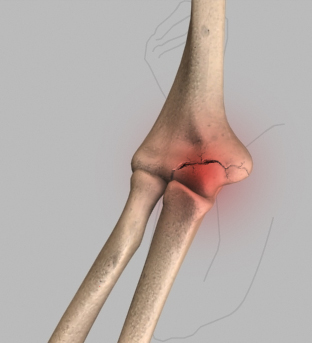
Elbow Anatomy
The arm in the human body is made up of three bones that join to form a hinge joint called the elbow. The upper arm bone or humerus connects from the shoulder to the elbow to form the top of the hinge joint. The lower arm or forearm consists of two bones, the radius and the ulna. These bones connect the wrist to the elbow forming the bottom portion of the hinge joint.
What are Elbow Fractures?
Elbow fractures may occur from trauma, such as a fall onto an outstretched arm, a direct blow to the elbow or an abnormal twist to the joint beyond its functional limit.
What are the Types of Elbow Fractures?
The types of elbow fractures include:
- Radial head and neck fractures: Fractures in the upper portion of the radius bone
- Olecranon fractures: These are the most common elbow fractures, occurring at the bony prominence of the ulna at the back of the elbow.
- Distal humerus fractures: These fractures are common in children and the elderly.
Symptoms of Elbow Fractures
The symptoms of an elbow fracture may include pain, bruising, stiffness, swelling in and around the elbow, a popping or cracking sound and deformity of the elbow bones.
Diagnosis of Elbow Fractures
To diagnose an elbow fracture, your doctor will review your history, perform a thorough physical examination and order X-rays of the joint. In some cases, a CT scan may be needed to view the details of the joint surface.
Treatment Options for Elbow Fractures
The aim of treatment is to restore the anatomy, maximize early motion and reduce the risk of stiffness. Non-surgical treatment options include ice application, the use of a splint or a sling to immobilize the elbow during the healing process, and physical therapy.
Surgery is indicated in displaced and open fractures to realign the bones and stabilize the joint with plates and/or screws. Strengthening exercises are recommended to improve the range of motion.
Related Topics
- Triceps Injuries
- Osteochondritis Dissecans of the Capitellum
- Elbow Trauma
- Elbow Arthritis
- Bicep Tendon Tear at the Elbow
- Elbow Dislocation
- Triceps Tendonitis
- Elbow (Olecranon) Bursitis
- Elbow Sprain
- Tennis Elbow
- Golfer's Elbow
- Little League Elbow
- Nursemaid's Elbow
- Elbow Pain
- Elbow Contracture
- Distal Humerus Fractures of the Elbow
- Radial Head Fractures of the Elbow
- Elbow Fractures
- Ulnar Nerve Neuropathy
- Loose Bodies in the Elbow
- Radial Tunnel Syndrome
- Lateral Ulnar Collateral Ligament Injuries (Elbow)
- Post-traumatic Stiffness (Elbow)
- Cubital Tunnel Syndrome (Ulnar Nerve Entrapment)





